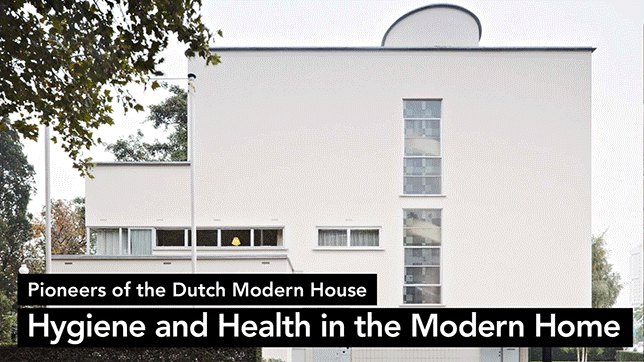Film and Conference Modules
Pioneers of the Dutch Modern House
This program consists of five modules, each with a keynote lecture and an episode of a series of thematic videos in which twenty iconic houses across the Netherlands are featured: from the Amsterdam School and De Stijl to Postmodernism; from Gerrit Rietveld to Mart van Schijndel and many others. We also offer the five thematic videos as one film of an hour. The film also presents famous examples of social housing, an area in which The Netherlands was particularly rich in the 20th-century.

Film Pioneers of the Dutch Modern House
Video on demand.
Language: Dutch spoken with English subtitles.
Twenty modern house museums in The Netherlands are introduced by Hetty Berens, Valentijn Carbo, Natalie Dubois, Robert von der Nahmer, and Natascha Drabbe.
Film Pioneers of the Dutch Modern House
How did progressive architecture develop in The Netherlands in the past hundred years and what have the residents of 'normal houses' gained from the wild experiments that the architects have sometimes carried out? We have put the strongest examples of innovative, avant-garde residential architecture in the spotlight for you in this film.
Hygiene and Health in the Modern Home
Hetty Berens, an architectural historian and curator at Het Nieuwe Instituut Rotterdam, is also responsible for the Sonneveld House in Rotterdam, which has been restored to its original 1930s glory. She is a board member of the Iconic Houses Foundation and Co-Chair of the 2021 conference. In this episode she explains how improved hygiene made healthier homes in The Netherlands.
Houses featured in this episode are:
- De Kiefhoek, J.J.P. Oud, 1930
- Erasmuslaan Model Home, Gerrit Rietveld, 1931
- Sonneveld House, Brinkman & Van der Vlugt, 1933
- Dijkstra House, Ben Merkelbach and Charles Karsten, 1934
- Kraayeveld House, now Chabot Museum, G.W. Baas, 1938
Palaces for the People
Valentijn Carbo is is an architectural historian at the leading private trust for the preservation of historic houses in the Netherlands, the Hendrick de Keyser Association. In the Model Home of Museum Het Schip he explains what building for the masses in the 1920s and 50s looked like and connects the projects either by their differences or similarities.
Houses featured in this episode are:
- Model Home in Museum Het Schip, Michel de Klerk (and the slum dwelling), 1921
- De Papaverhof, Jan Wils, 1921
- Van Eesteren House Museum, Nielsen Spruit & Van de Kuile, 1952
- Polman House,Lotte Stam-Beese and Ernest Groosman, 1956
- Robijnhof Model Home, Gerrit Rietveld, 1958
A Woman’s Place: Clients & Architects
Natalie Dubois is curator of applied art and design at the Centraal Museum Utrecht. Among other things, she is responsible for the three Rietveld houses that are being managed by the museum. Natalie studied art history at the UvA (Amsterdam) and NYU (New York) and museology at the Reinwardt Academy (Amsterdam).
In this episode Natalie tells us about the different and important roles that women played in the Netherlands: Helene Kröller-Müller as client, Truus Schröder-Schräder as co-designer and Lotte Stam-Beese as architect.
Houses featured in this episode are:
- Country Residence/Museum Jachthuis Sint Hubertus, H.P. Berlage, client Helene Kröller-Müller, 1920
- Rietveld Schröder House, Gerrit Rietveld, client/co-designer Truus Schröder-Schräder, 1924
- Polman House, architect Lotte Stam-Beese, 1956
Experiments with Space
Robert von der Nahmer is an architect and the owner of the Diagoon House, an experimental home by Herman Hertzberger, and a member of Iconic Houses. A graduate of the Royal Academy of Fine Arts in The Hague and the Academy of Architecture and Urban Design in Rotterdam, he was an architect at Alkemade & Von der Nahmer and the multidisciplinary design agency ProForma while also teaching widely, including at the Academy of Architecture and Urban Design. He lives in the Diagoon House in Delft. His film is about the search for architectural and visual ways to guide and intensify our experience of space and time, and experiments involving these. It explores what in Dutch is called 'wooncultuur' – the culture of living in our homes.
Houses featured in this episode are:
- Van Doesburg Rinsemahuis, Theo van Doesburg, 1921
- Van Zessen House, Cornelis van Eesteren, 1923
- Diagoon House, Herman Hertzberger, 1971
- Cube House, Piet Blom, 1984
- Wall House #2, John Hejduk, 2001
Home as Self-Portrait: Architect's Houses
Natascha Drabbe is the founder and executive director of the Iconic Houses network. She graduated in architectural history from Utrecht University and has published, curated, lectured and been a member of design and architecture juries at home and abroad. She was an international project manager at the Dutch Design Foundation (Premsela) from 2002 to 2006. In 2007, she set up the Mart van Schijndel Foundation, in order to keep that architect’s ideas alive and make his home in Utrecht available for guided tours, lectures and film screenings. This was followed by launch of the Iconic Houses Foundation in 2008 and the website iconichouses.org in 2012. International Iconic Houses conferences have been held in London, Barcelona, Los Angeles and New Canaan.
Houses that architects design for themselves are like test labs for new ideas. In the four houses that are central to this episode, we see the architects Van Ravesteyn, Jan de Jong, Mart van Schijndel and the Kortekaas artists duo putting their theories into practice down to the smallest detail. We also see what a challenge it is to build an experimental house with the small budget that architects usually have for their own homes. As a result, they often experiment with unorthodox, cheap building materials, which later leads to major restoration issues. Natascha lives in the Van Schijndel House in Utrecht.
Houses featured in this episode are:
- Sybold van Ravesteyn House, Sybold van Ravesteyn, 1932
- Jan de Jonghuis, Jan de Jong, 1956-1983
- Van Schijndel House, Mart van Schijndel, 1992
- The Tempelhof, Huub & Adelheid Kortekaas, 1995-1999